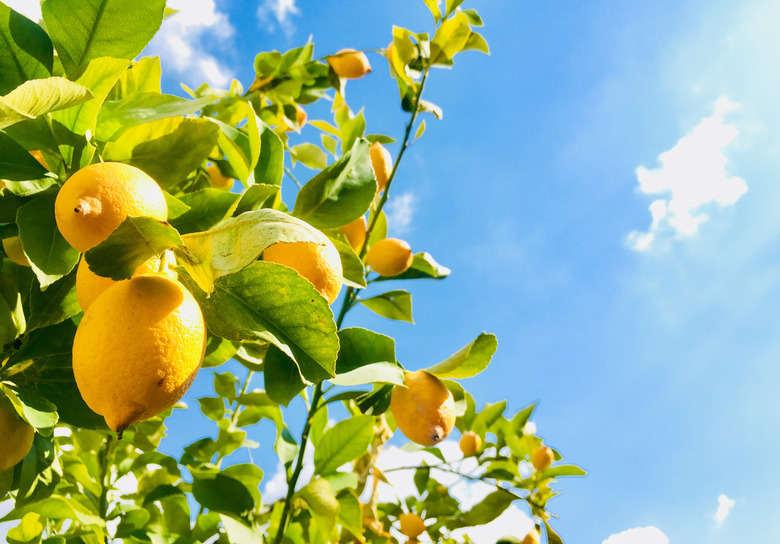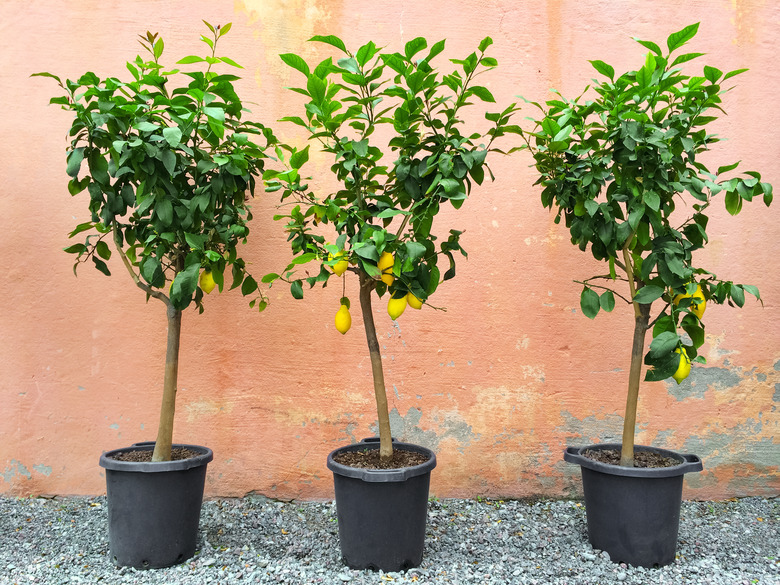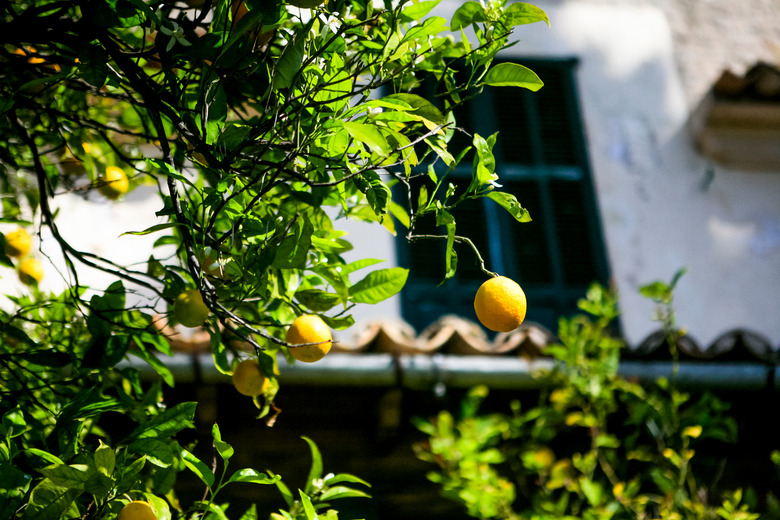How To Grow Lemons
We may receive a commission on purchases made from links.
When life hands you lemons (Citrus x limon), you should make lemonade, so the expression goes, but if you prefer literal lemons to proverbial ones, you might want to grow your own lemon tree. Those tart yet sweet fruits are good for more than just making lemonade — they make a great addition to many foods and beverages, have medicinal benefits and are even great for cleaning. Plus, the glossy foliage, 1-inch-wide flowers and fist-sized yellow fruits make the trees an attractive addition to any yard. While lemon trees can only be grown outdoors in reasonably warm and temperate climates within USDA zones 9 through 11, they do well in pots, so people outside this hardiness range across the United States can enjoy these easy-to-grow, drought-tolerant fruit trees.
Best Uses for Lemons
Best Uses for Lemons
How can you best use a lemon? Let us count the ways:
- Flavor: Native to south Asia but widely grown around the world, lemons
are best known for their flavor. They serve as the stand-out
ingredient in lemonade, lemon-meringue pie, lemon curd, lemon tea, lemon bars
and more. They can also be used in marinades, to season fish, to enhance
the flavor of other fruits, to improve the flavor of tea and more. The yellowy
zest is frequently used in soups, baked goods and herbal teas. - Health: Like all citrus fruits, lemons are filled with vitamin
C, which helps prevent immune-system deficiencies, eye disease, cardiovascular
disease, wrinkles and prenatal problems. In fact, a single lemon contains
51 percent of your daily recommended vitamin C. Lemons may also help with
weight loss, prevent kidney stones, reduce your cancer risk, lower your risk of
getting anemia and improve your digestive health. - Natural Cleaner: Beyond that, lemon juice is also widely used as a natural cleaner, especially when combined with vinegar, rubbing alcohol or dish soap.
The fresh scent also makes a wonderful air freshener, which can be sprayed just
about anywhere if combined with rubbing alcohol.
Tip
You don't need to worry about rationing your lemons for one purpose or another when you have your own tree. That's because one single mature lemon tree can produce an amazing 100 pounds of fruit every year. Of course, production will vary based on the variety, age, and size of your tree, with dwarf trees grown in a pot naturally producing fewer fruits than a full-sized tree grown outdoors.
Types of Lemon Varieties
Types of Lemon Varieties
There are many lemon varieties from which to choose, all of which offer their own benefits. One of the most popular cultivars is Citrus x limon 'Meyer,' which features a thin, easy-to-peel skin that protects the sweeter-than-average fruit said to be a cross between a lemon and a mandarin-pomelo hybrid. Meyer lemons aren't just popular for their tasty fruit but also because they grow a manageable 10 to 15 feet tall, making them a better fit for smaller yards since traditional lemon trees usually grow 20 feet high.
Two primary groups of lemons are the Eureka and Lisbon groups. Eureka-type lemons are common choices for home growers since they are drought tolerant, resistant to most pests and diseases, and easy to grow, even in a variety of soils. Additionally, this dwarf variety does well in pots, growing only 8 to 10 feet compared to the full-size tree that grows 20 feet tall. Eureka lemon trees bear attractive fruits that are bright yellow with green streaks when immature and easy to use in recipes since they have few seeds. Eureka lemons are popular in part because they fruit throughout the year, with slightly less fruit in late summer and fall than the rest of the year.
Lisbon-type lemons best represent the classic lemon that most people imagine, with medium-sized fruit and textured, medium-thick peel that is bright yellow when mature. Lisbon lemons do well with heat and drought, and they do better with frost compared to other lemon varieties.
How to Grow Lemons
How to Grow Lemons
Starting Lemons From Seed
Lemons are easy to grow from seed, even though commercial lemon trees are grafted plants. Seed-started trees are slow to bear, and the fruits may not resemble the lemon from which you extracted the seed to start your tree. Start by finding a home-grown lemon or organic store-bought lemon. Keep in mind that commercially grown, nonorganic lemons generally have seeds that won't germinate.
- Start plants indoors in a small pot filled with potting mix, moistening the soil so it is damp all the way through.
- Gently rinse the
seeds in water right when you're prepared to sow them since fresher seeds
are more likely to germinate, and dry seeds will not germinate at all. - Bury a
handful of seeds about 1/2 inch deep. - Lightly spray the soil to help settle it
back into place and then cover the pot with plastic wrap to trap moisture. - Use a fork or toothpick to poke small holes in the top of the cover and then
place the pot in a bright-light location out of direct sun. - Check the soil daily, lightly spraying water on the surface and
making sure not to oversaturate the soil. Always return the cover over the
pot. - Seedlings will take about two weeks to emerge, at which point you should
remove the plastic wrap to allow the seedlings space to grow while continuing to
add water daily so the soil stays moist. - Apply a water-soluble fertilizer with
high potassium levels after one month and continue to do so once every two to
four weeks.
Your seedlings will be ready to transplant when they have several sets of leaves. Here's how to do it:
- Carefully separate the seedlings and their roots and then
plant them in larger pots, approximately 4 to 6 inches in diameter, placing the pots in a sunny location. - Continue to keep the soil
moist but not soggy and keep fertilizing once or twice a month. - When your seedlings
begin to outgrow their containers, they should be planted outdoors or in a
larger pot if you intend to keep them potted. - When replanting outside, transplant the seedlings in early
spring so they will have a while to settle in before the heat of midsummer. - Choose a sunny, south-facing location where the tree will get at least six hours
of sunlight per day. - Dig holes twice as wide as the pot holding your young
lemon trees and plant seedlings at the same depth they were in the pot. - Water well and add a 3-inch
layer of mulch around the tree's roots 2 inches away from the trunk.
In What Zone Do Lemons Grow Best?
In What Zone Do Lemons Grow Best?
When grown outdoors, lemons do best in zones 9 through 11, which have long, warm summers and temperate winters. They like humidity but will grow just fine in dry areas as long as they get sufficient water.
That being said, even gardeners in chilly areas can grow lemons as long as they plant them in containers that can be brought inside during the winter. The most important thing is that they receive ample sun, so place them in a sunny window that receives at least four and ideally closer to eight hours of sunlight per day. For best results with potted lemons, choose a dwarf variety that can be more easily moved.
When Should You Plant Lemons?
When Should You Plant Lemons?
The best time to plant lemons indoors is simple — whenever you have fresh lemons. Since the plants are best started indoors with seeds straight out of the fruit, the season really doesn't matter, especially since many varieties will fruit throughout the year. On the other hand, the time of year does matter when it comes to planting your trees outside. It is best to transplant lemon trees outdoors in spring so they will not immediately be hit by extreme temperatures.
Soil, Sunlight and Water Recommendations for Lemons
Soil, Sunlight and Water Recommendations for Lemons
Overall, lemons are not too particular when it comes to soil. Trees will be the largest and most productive when grown in well-draining, loamy soil that is slightly acidic, but they'l grow and produce in nearly any soil except heavy clay, as it does not drain well enough. Keeping the soil mulched can help maintain proper moisture levels and reduce weed growth. For best results, apply a citrus fertilizer every four to six weeks from February through August.
Lemons like lots of sunlight and require a minimum of four hours every day, though eight hours is ideal. Unfortunately, trunks can suffer from damage when exposed to harsh, direct sun, so you may want to trees them next to a fence. Avoid pruning during late spring or summer.
While most types of lemon trees are drought tolerant, it's best to water once or twice per week when you do not get at least 1 inch of rain. This will ensure you get the most flavorful fruit. Do not overwater or you could put your trees at risk of disease. If you're not sure if your trees need water, check the top 2 inches of soil. If it is dry, add more water. When growing lemon trees as houseplants during the winter months, mist the trees daily or run a humidifier near the plants to help negate the excessively dry air caused by indoor heaters.
How to Winterize Lemons
How to Winterize Lemons
Because lemons don't grow in areas with particularly cold winters, they don't generally need to be winterized in the traditional sense, but winter is the best time to prune the trees, which is important for the health of the trees and increases yields. The goal of pruning is to remove unhealthy and poorly positioned branches but always avoid overpruning, which can cause the tree trunk to become sunburned and can reduce the growth and crop size of the tree. Ideally, you should prune between crops, but if your tree grows fruit year-round, it still needs to be pruned, so try to time it for when there are minimal fruits and buds on the branches.
When trees are young, try to limit the number of main branches on the tree to about eight, as having too many main branches can cause crowding and weakening in the tree as it ages. Throughout the tree's life, prune branches that cause crowding, particularly in the center of the tree where they will reduce light penetration and airflow. Always remove dead and unhealthy branches when you notice them and trim branches located too close to the ground, as this may allow insects easier access to the tree.
If you have a potted lemon tree, don't forget to bring your tree inside during the winter to protect it from frost. Ensure it is placed in a location that gets at least four hours of sunlight per day and prune it before placing it back outside in the spring.
How to Harvest Lemons
How to Harvest Lemons
Lemon trees blossom in their second or third year and start fruiting anywhere from four to 12 months from that time. Different types of lemon trees will be ready to harvest in different seasons, with some fruiting throughout the year. Some species are ready to harvest when they are bright yellow, while others are pale yellow or even yellow-green. Be sure to do research on your variety to find out when it will fruit and what it should look like when mature.
Generally speaking, you can tell a lemon is ready for harvest when it pulls off the tree with a light tug. When harvesting, be mindful of the sharp thorns on the branches of some types of lemon trees.
Common Pests and Other Problems for Lemons
Common Pests and Other Problems for Lemons
Lemon trees and most citrus trees are fairly resilient, but they can still be affected by many common pests. Additionally, while they love sun, lemon trees' bark can be sunburned in direct sunlight, which is why it is a good idea to prune the trees in winter so the canopy can be repaired to provide protection from the sun by the summer. If the branches are too thin and you notice the trunk is looking sunburned, meaning it has brown, raised lesions in the spots where the sun shines the brightest, apply a latex-based paint to the trunk to protect against further damage.
The most common insects that cause problems in lemon trees are aphids, spider mites, and fungus gnats, all of which can be killed by predatory insects, like ladybugs, or with insecticidal soap. Aphids do not present great threats to adult lemon trees, although they can carry diseases, such as tristeza. Spider mites can suck nutrients from leaves, which can cause foliage to die off. Spider mites can easily be identified since they leave a weblike mess on the branches. Fungus gnats look similar to fruit flies, and though the adults do not pose a threat to lemon trees, the larvae live in the soil and can feed on lemon trees, which can kill the tree if the infestation is bad enough.
Common Diseases for Lemons
Common Diseases for Lemons
Lemon trees can be infected by a number of diseases, including tristeza and botrytis. One of the most problematic diseases is tristeza, which is a fungal disease spread by aphids. It can be identified by the discoloration or dropping of leaves, stunted growth, and poor fruit production, and the root rot caused by the disease can often kill trees entirely. The best way to prevent this deadly citrus disease is to stop aphid infestations as soon as possible and encourage ladybugs in your yard.
One problem that occurs more commonly in lemon trees than other citrus types is botrytis. This disease causes velvety growths in brown and gray colors to appear on twigs and blossoms, causes new growth to die back and makes fruit and leaves drop early. Because this disease thrives in locations with cool, wet weather, ensure your lemons are planted in areas with full sun and encourage light and air penetration through proper pruning.


